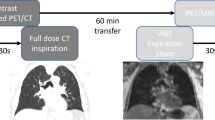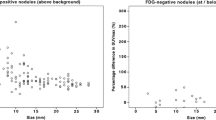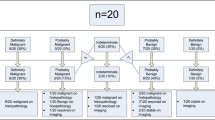Abstract
Purpose
The purpose of this study was to determine the accuracy of detection of small pulmonary nodules on quiet breathing attenuation correction CT (CTAC) and FDG-PET when performing integrated PET/CT, as compared with a diagnostic inspiratory CT scan acquired in the same imaging session.
Methods
PET/CT scans of 107 patients with a history of carcinoma (54 male and 53 female, mean age 57.3 years) were analyzed. All patients received an integrated PET/CT scan including a CTAC acquired during quiet respiration and a contrast-enhanced CT acquired during inspiration in the same session. Breathing CTAC scans were reviewed by two thoracic radiologists for the presence of pulmonary nodules. FDG-PET scans were reviewed to determine accuracy of nodule detection. Diagnostic CT was used as the gold standard to confirm or refute the presence of nodules.
Results
On the CTAC scans 200 nodules were detected, of which 183 were true positive (TP) and 17, false positive. There were 109 false negatives (FN). Overall, 51 (48%) patients had a false interpretation, including 19 in whom CT was interpreted as normal for lung nodules. The average size of the nodules missed was 3.8±2 mm (range 2–12 mm). None of the nodules missed on the CTAC scans were detected by PET. In the right lung there were 20 TP, 42 true negative (TN), 11 FP, and 34 FN interpretations with a sensitivity in nodule detection of 37% (CI 24–51%) and a specificity of 79% (CI 66–89%). In the left lungs there were 16 TP, 65 TN, 3 FP, and 23 FN interpretations, with a sensitivity of 41% (CI 26–58%) and a specificity of 96% (CI 88–99%).
Conclusion
The detection of small pulmonary nodules by breathing CTAC and FDG-PET is relatively poor. Therefore an additional diagnostic thoracic CT scan obtained during suspended inspiration is recommended for thorough evaluation of those patients in whom detection of pulmonary metastases is necessary for management.



Similar content being viewed by others
References
Dewan NA, Gupta NC, Redepenning LS, Phalen JJ, Frick MP. Diagnostic efficacy of PET-FDG imaging in solitary pulmonary nodules. Potential role in evaluation and management. Chest 1993;104:997–1002
Fischer BM, Mortensen J, Dirksen A, Eigtved A, Hojgaard L. Positron emission tomography of incidentally detected small pulmonary nodules. Nucl Med Commun 2004;25:3–9
Gupta NC, Frank AR, Dewan NA, Redepenning LS, Rothberg ML, Mailliard JA, et al Solitary pulmonary nodules: detection of malignancy with PET with 2-[F-18]-fluoro-2-deoxy-D-glucose. Radiology 1992;184:441–444
Gupta NC, Maloof J, Gunel E. Probability of malignancy in solitary pulmonary nodules using fluorine-18-FDG and PET. J Nucl Med 1996;37:943–948
Patz EF Jr, Lowe VJ, Hoffman JM, Paine SS, Burrowes P, Coleman RE, et al. Focal pulmonary abnormalities: evaluation with F-18 fluorodeoxyglucose PET scanning. Radiology 1993;188:487–490
Benjamin MS, Drucker EA, McLoud TC, Shepard JA. Small pulmonary nodules: detection at chest CT and outcome. Radiology 2003;226:489–493
Beyer T, Antoch G, Muller S, Egelhof T, Freudenberg LS, Debatin J, et al. Acquisition protocol considerations for combined PET/CT Imaging. J Nucl Med 2004;45:25S–35
de Juan R, Seifert B, Berthold T, von Schulthess GK, Goerres GW. Clinical evaluation of a breathing protocol for PET/CT. Eur Radiol 2004;14:1118–1123
Goerres GW, Burger C, Kamel E, Seifert B, Kaim AH, Buck A, et al Respiration-induced attenuation artifact at PET/CT: technical considerations. Radiology 2003;226:906–910
Goerres GW, Kamel E, Seifert B, Burger C, Buck A, Hany TF, et al Accuracy of image coregistration of pulmonary lesions in patients with non-small cell lung cancer using an integrated PET/CT system. J Nucl Med 2002;43:1469–1475
Coleman RE, Delbeke D, Guiberteau MJ, Conti PS, Royal HD, Weinreb JC, et al Concurrent PET/CT with an integrated imaging system: intersociety dialogue from the joint working group of the American College of Radiology, the Society of Nuclear Medicine, and the Society of Computed Body Tomography and Magnetic Resonance. J Nucl Med 2005;46:1225–1239
Swensen SJ, Jett JR, Hartman TE, Midthun DE, Sloan JA, Sykes AM, et al Lung cancer screening with CT: Mayo Clinic experience. Radiology 2003;226:756–761
Diederich S, Thomas M, Semik M, Lenzen H, Roos N, Weber A, et al Screening for early lung cancer with low-dose spiral computed tomography: results of annual follow-up examinations in asymptomatic smokers. Eur Radiol 2004;14:691–702
Libby DM, Smith JP, Altorki NK, Pasmantier MW, Yankelevitz D, Henschke CI. Managing the small pulmonary nodule discovered by CT. Chest 2004;125:1522–1529
Henschke CI, Shaham D, Farooqi A, Yankelevitz DF. Computerized tomography screening for lung cancer: new findings and diagnostic work-up. Semin Thorac Cardiovasc Surg 2003;15:397–404
Fischbach F, Knollmann F, Griesshaber V, Freund T, Akkol E, Felix R. Detection of pulmonary nodules by multislice computed tomography: improved detection rate with reduced slice thickness. Eur Radiol 2003;13:2378–2383
Antoch G, Freudenberg LS, Egelhof T, Stattaus J, Jentzen W, Debatin JF, et al Focal tracer uptake: a potential artifact in contrast-enhanced dual-modality PET/CT scans. J Nucl Med 2002;43:1339–1342
Beyer T, Antoch G, Bockisch A, Stattaus J. Optimized intravenous contrast administration for diagnostic whole-body18F-FDG PET/CT. J Nucl Med 2005;46:429–435
Beyer T, Antoch G, Blodgett T, Freudenberg LF, Akhurst T, Mueller S. Dual-modality PET/CT imaging: the effect of respiratory motion on combined image quality in clinical oncology. Eur J Nucl Med Mol Imaging 2003;30:588–596
Cohade C, Osman M, Marshall LN, Wahl RN. PET-CT: accuracy of PET and CT spatial registration of lung lesions. Eur J Nucl Med Mol Imaging 2003;30:721–726
Osman MM, Cohade C, Nakamoto Y, Marshall LT, Leal JP, Wahl RL. Clinically significant inaccurate localization of lesions with PET/CT: frequency in 300 patients. J Nucl Med 2003;44:240–243
Kim JS, Kim JH, Cho G, Bae KT. Automated detection of pulmonary nodules on CT images: effect of section thickness and reconstruction interval—initial results. Radiology 2005;236:295–299
Carretta A, Ciriaco P, Canneto B, Nicoletti R, Del Maschio A, Zannini P. Therapeutic strategy in patients with non-small cell lung cancer associated to satellite pulmonary nodules. Eur J Cardiothorac Surg 2002;21:1100–1104
Picci P, Vanel D, Briccoli A, Talle K, Haakenaasen U, Malaguti C, et al Computed tomography of pulmonary metastases from osteosarcoma: the less poor technique. A study of 51 patients with histological correlation. Ann Oncol 2001;12:1601–1604
Headrick JR, Miller DL, Nagorney DM, Allen MS, Deschamps C, Trastek VF, et al Surgical treatment of hepatic and pulmonary metastases from colon cancer. Ann Thorac Surg 2001;71:975–980
Pfannschmidt J, Muley T, Hoffmann H, Dienemann H. Prognostic factors and survival after complete resection of pulmonary metastases from colorectal carcinoma: experiences in 167 patients. J Thorac Cardiovasc Surg 2003;126:732–739
Bacci G, Mercuri M, Briccoli A, Ferrari S, Bertoni F, Donati D, et al Osteogenic sarcoma of the extremity with detectable lung metastases at presentation. Results of treatment of 23 patients with chemotherapy followed by simultaneous resection of primary and metastatic lesions. Cancer 1997;79:245–254
Leung AN. Spiral CT of the thorax in daily practice: optimization of technique. J Thorac Imaging 1997;12:2–10
Heiken JP, Brink JA, Vannier MW. Spiral (helical) CT. Radiology 1993;189:647–656
Acknowledgements
This study was approved by our institution’s human subjects research committee and the methods complied with Health Insurance Portability and Accountability Act (HIPAA) of the United Stages of America.
Author information
Authors and Affiliations
Corresponding author
Rights and permissions
About this article
Cite this article
Aquino, S.L., Kuester, L.B., Muse, V.V. et al. Accuracy of transmission CT and FDG-PET in the detection of small pulmonary nodules with integrated PET/CT. Eur J Nucl Med Mol Imaging 33, 692–696 (2006). https://doi.org/10.1007/s00259-005-0018-x
Received:
Accepted:
Published:
Issue Date:
DOI: https://doi.org/10.1007/s00259-005-0018-x




